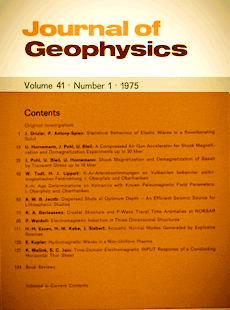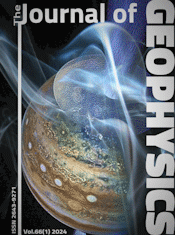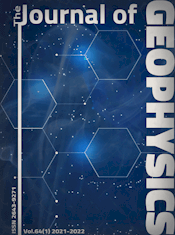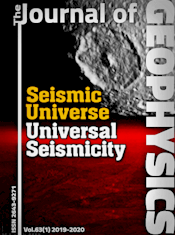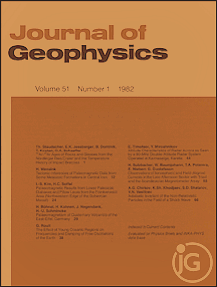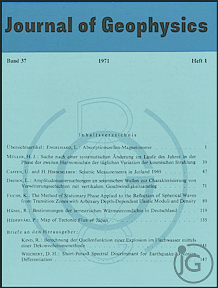Shock magnetization and demagnetization of basalt by transient stress up to 10 kbar
Article Sidebar
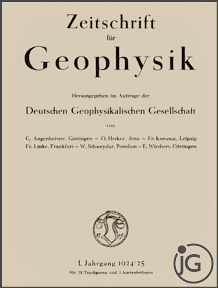
Vols. 1-18 (1924-1944), ISSN 0044-2801
Main Article Content
Abstract
The effect of stress waves on the magnetization of basalt was studied. The stress waves were generated by impacting cylindrical basalt samples with aluminium projectiles. The 3 mm thick aluminium plates were accelerated in a non-magnetic compressed air gun accelerator to velocities ranging from 20 to 160 m/s, corresponding to peak stresses in the basalt between 2.5 and 10 kbar. The duration of the stress impulse was about several micro-seconds. For the experiments a basalt with well-known magnetic properties was used (Rauher Kulm, Germany). The magnetizing effect of the stress waves was determined as a function of the number of impacts, the intensity and direction of the applied magnetic field ( < 10 Oe) and the peak stress amplitude. In the used stress range the measured shock remanent magnetization (SRM) tends to a final steady value after 5 or 6 impacts. This value is proportional to the intensity of the applied field and increases with the peak stress applied. The produced SRM can be erased with maximum ac-fields of about 150 to 200 Oe. Any dependance of SRM on the direction of the applied magnetic field could not be recognized within the accuracy limits of the experiments. The demagnetizing effect of stress waves on the highfield (1,000 Oe) isothermal remanent magnetization, the low-field (1 Oe) thermoremanent magnetization and the natural remanent magnetization was studied as a function of the number of impacts and the peak stress. A final steady state of magnetization is generally obtained after 4 or 5 impacts. With increasing peak stresses increasingly harder remanent magnetizations can be demagnetized, with stresses of 2.5 kbar corresponding to coercive forces of about 75 Oe, 5.5 kbar to about 125 Oe and 8 kbar to about 175 Oe.
 ARK: https://n2t.net/ark:/88439/y023624
ARK: https://n2t.net/ark:/88439/y023624
Permalink: https://geophysicsjournal.com/article/182
Article Details
References
Barsukov, O.M., Skovorodkin, Y.P. (1969) Magnetic observations in the region of the Medeo blast work. Izvestiya, Solid Earth, 310-311 (English edition)
Creer, K.M., Petersen, N. (1969) Thermochemical magnetization in basalts. Geophys. J. 35:501-516
Creer, K.M., Petersen, N., Petherbridge, J. (1970) Partial self-reversal of remanent magnetization and anisotropy of viscous magnetization in basalts. Geophys. J. 21:471-483
Davis, P.M., Stacey, F.D. (1972) Geomagnetic anomalies caused by a man-made lake. Nature 240:348-349
Domen, H. (1961) A note on remanent magnetism caused by impulsive pressure. Bull. Fae. Educ. Yamaguchi Univ. 10:71-76
Dunlop, D.J., Hanes, J.A., Buchan, K.L. (1973) Indices of multidomain magnetic behaviour in basic igneous rocks: Alternating-field demagnetization, hysteresis and oxide petrology. J. Geophys. Res. 78:1387-1393
Dunlop, D.J., Ozima, M., Kinoshita, H. (1969) Piezomagnetization of single-domain grains: A graphical approach. J. Geomagn. Geoelectr. 21:513-518
Gerlach, W. (1949) Uber den Erschtitterungseinflul3 auf die Magnetisierung und seine Temperaturabhangigkeit. Helv. Phys. Acta 22:142-148
Hargraves, R.B., Perkins, W.E. (1969) Investigations of the effect of shock on natural remanent magnetism. J. Geophys. Res. 74:2576-2589
Hasbrouck, W.P., Allen, J.H. (1972) Quasi-static magnetic field changes associated with the Cannikin nuclear explosion. Bull. Seismal. Soc. Am. 62:1479-1487
Helbig, K. (1965) Optimum configuration for the measurements of the magnetic moment of samples of cubical shape with a flux-gate magnetometer. J. Geomagn. Geoelectr. 17:373-380
Hornemann, U., Pohl, J., Bleil, U. (1975) A compressed air gun accelerator for shock magnetization and demagnetization experiments up to 20 kbar. J. Geophys. 41:13-22
Johnston, M.J.S., Stacey, F.D. (1969) Transient magnetic anomalies accompanying volcanic eruptions in New Zealand. Nature 224:1289-1290
Koenigsberger, J.G. (1932) Uber remanenten Magnetismus von Gesteinen. Gerlands Beitr. Geophys. 35:204-216
Koenigsberger, J.G. (1936) Die Abhangigkeit der nattirlichen remanenten Magnetisierung bei Eruptivgesteinen van deren Alter und Zusammensetzung. Beitr. angew. Geophys. 5:193-246
Kulterman, R.W., Neilson, F.W., Benedick, W.B. (1958) Pulse Generator based on high shock demagnetization of ferromagnetic material. J. Appl. Phys. 29:500-501
Lowrie, W., Fuller, M. (1971) On the alternating field demagnetization characteristics of multi-domain thermoremanent magnetization in magnetite. J. Geophys. Res. 76:6339-6349
Nagata, T. (1970) Effects of a uniaxial compression on remanent magnetizations of igneous rocks. Pageoph 78:100-109
Nagata, T. (1970) Basic magnetic properties of rocks under the effects of mechanical stresses. Tectonophysics 9:167-195
Nagata, T. (1971) Introductory notes on shock remanent magnetization and shock demagnetization of igneous rocks. Pageoph 89:159-177
Nagata, T., Carleton, B.J. (1969) Notes on piezo-remanent magnetization of igneous rocks (III). J. Geomagn. Geoelectr. 21:623-645
Petersen, N. (1966) Beobachtung einiger mineralogischer und magnetischer Eigenschaften dreier Basaltproben nach unterschiedlicher thermischer Behandlung. J. Geomagn. Geoelectr. 18:463-479
Pohl, J. (1967) Magnetisierung und Entmagnetisierung von Stahl und Magnetit
Pohl, J. (1971) Magnetisierung der Gesteine und Interpretation der Anomalien des Erdmagnetfeldes im Ries-Krater. Dissertation, University of Munich
Refai, E. (1960) Magnetfeld und Magnetisierung der Basaltvorkommen im Raum van Kemnath. Z. Geophys. 27:175-187
Rikitake, T. (1968) Geomagnetism and earthquake prediction. Tectonophysics 6:59-68
Schmidbauer, E., Petersen,N. (1968) Some magnetic properties of two basalts under uniaxial compression measured at different temperatures. J. Geomagn. Geoelectr. 20:169-180
Schmucker, U. (1957) Gesteinsmagnetische Untersuchungen und Experimente am Basalt des Steinberges bei Barlissen. Abh. Akad. Wissensch. Gottingen, Math.Phys. Klasse, Nr. 26, 100 S., Goettingen
Shapiro, V.A., Ivanov, N.A. (1966) The stability parameters of dynamic magnetization compared with other types of remanent magnetization. Izvestiya, Solid Earth 681-685 (English edition)
Shapiro, V.A., Ivanov, N.A. (1967) Dynamic remanence and the effect of shocks on the remanence of strongly magnetic rock. Dokl. Akad. Nauk. USSR 173:1065-1068
Short, N.M. (1966) Effects of shock pressures from a nuclear explosion on mechanical and optical properties of granodiorite. J. Geophys. Res. 71:1195-1215
Soffel, H. (1968) Die Bereichsstrukturen der Titanomagnetite in zwei tertiaren Basal ten und die Beziehung zu makroskopisch gemessenen magnetischen Eigenschaften dieser Gesteine. Habilitationsschrift, Naturwiss. Fak. Univ. Munich
Stacey, F.D. (1964) The seismomagnetic effect. Pageoph 58:5-22
Stacey, F.D., Barr, K.G., Robson, G.R. (1965) The volcano-magnetic effect. Pageoph 62:96-104
Stacey, F.D., Johnston, M.J.S. (1972) Theory of the piezomagnetic effect in titanomagnetite-bearing rocks. Pageoph 97:146-155
Talwani, P., Kovach, R.L. (1972) Geomagnetic observations and fault creep in California. Tectonophysics 14:245-256
Zinsser, H. (1970) Induzierte und remanente, insbesonders thermoremanente Magnetisierung von Proben zweier Basaltvorkommen (Rauher Kulm und Parkstein, Oberpfalz) in Abhangigkeit von einaxialer Druckspannung. Diplomarbeit, Institute for Advanced Geophysics, University of Munich


